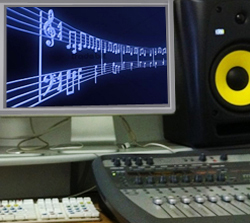The hallmark of a great recording/mix for me is one where the music all lives within a tangible, dimensional world. The exception being songs that call for a two-dimensional or more lo-fi approach.
In general, a recording that has width, height, and depth creates for a compelling sound.
And truthfully I think part of the magic of a song is pulling the listener into a different world — creating the illusion of that space only adds to that effect.
What is width, height, and depth? Just like in film or paintings we can create the illusion of three dimensions on a two-dimensional surface. In film, the surface is the screen, in paintings it’s the canvas, and in music it’s the stereo field.
The only difference is that with a screen or canvas, the height is already given simply by its existence, whereas with the stereo field we have to create an illusion of “top-to-bottom” dimension.
Height
So let’s start with height.
It’s a strange and interesting phenomenon that we hear high-pitched frequency content as coming from above, and the low tones coming from below.
Partially this is due to suggestion. We subconsciously equivocated “high” pitch with “high on a vertical scale”. Partially, this is due to common tweeter placement with speaker woofers most often being lower than the tweeter in vertical alignment.
Partially, this phenomenon is caused by the way low-frequency tones project. The wider dispersion of low tones allows them to reflect off the nearest surface such as your desk. Higher tones are more directional and will reach your ear without as much near reflection over short distances.
For these reasons and probably others, we tend to hear high harmonic content as “up” and low harmonic content as “down.” By creating contrast in the extremes of the frequency spectrum we can make a mix sound “tall.” If just one naturally bright element like a bell or hi hat is a touch brighter, and one low element like a kick or bass is a touch subby-er, the whole mix will expand.
Width
Width is also about contrast.
If two sounds are exactly the same and play at exactly the same time from each speaker, we perceive it as coming from a center point between the two speakers. This is often called the “phantom mono” or “phantom center.” The key here is similarity. As soon as the sounds become different or the timing becomes different they start to spread across the stereo field.
It stands to reason that two sounds that are easily localized (meaning our ear can clearly hear where the sound is coming from like a woodblock, triangle, or glockenspiel) played at different times will sound very wide. The greater the contrast between what’s happening in the left speaker versus the right speaker, the wider the image.



















